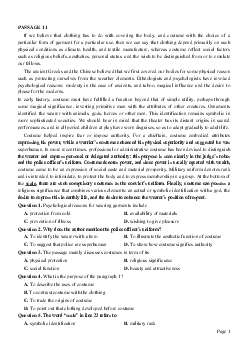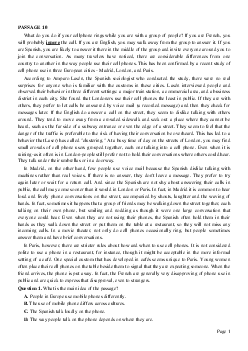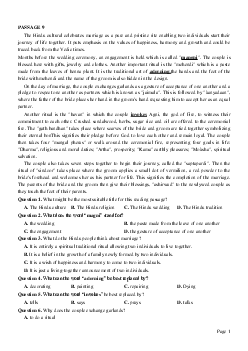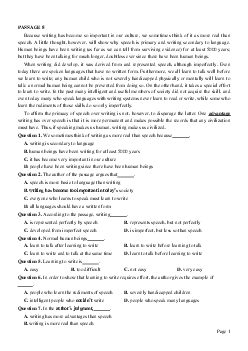


Preview text:
PASSAGE 2
Scientists have discovered the bones of what may be the largest meat-eating dinosaur ever to walk the
earth. The discovery was made by a team of researchers from Argentina and North America in Patagonia,
a desert on the eastern slopes of the Andes in South America. Besides the interesting fact that the
dinosaur was huge and horrifying, it is even more astounding that the bones of a number of the
dinosaurs were found together. This discovery challenges the prior theory that the biggest meat-eaters
lived as loners and instead indicates that they may have lived and hunted in packs. The Tyrannosaurus
Rex lived in North America and was believed to hunt and live alone.The newly discovered meat-eater
appears to be related to the Giganotosaurus family, being as closely related to it as a fox would be to a
dog. It is actually not of the same family at all as the Tyrannosaurus Rex, being as different from it as a
cat is from a dog. The fossilized remains indicate that the animals lived about 100 million years ago. With
needle-shaped noses and razor sharp teeth, they were larger than the Tyrannosaurus Rex, although their
legs were slightly shorter, and their jaws were designed to be better able to dissect their prey quickly and precisely.
Question 1. The author states that the newly discovered dinosaur remains are evidence that it was the largest A. dinosaur ever.
B. carnivorous dinosaur.
C. herbivorous dinosaur.
D. South American dinosaur.
Question 2. The word Besides in the first paragraph is closest in meaning to A. in spite of. B. in addition to. C. although. D. mostly
Question 3. The word horrifying in the first paragraph is closest in meaning to A. frightening. B. large. C. fast. D. interesting
Question 4. The word astounding in the first paragraph is closest in meaning to A. terrifying. B. pleasing. C. displeasing. D. surprising
Question 5. The author implies that the most interesting fact about the find is that this dinosaur
A. lived and hunted with others.
B. had a powerful jaw and sharp teeth.
C. was found in the Andes.
D. was larger than Tyrannosaurus Rex.
Question 6. The passage indicates that prior to this discovery scientists believed that
A. meat-eating dinosaurs lived alone.
B. there were no meat-eating dinosaurs in the Andes.
C. Tyrannosaurus Rex lived in the Andes.
D. meat-eating dinosaurs were small in stature.
Question 7. The word “ it” in the second paragraph refers to
A. newly discovered meat – eater B. relationship C. Giganotosaurus D. Dog
Question 8. The author states that the newly discovered meat-eating dinosaur is
A. closely related to Tyrannosaurus Rex.
B. not closely related to Tyrannosaurus Rex.
C. not closely related to Giganotosaurus.
D. closely related to the large cat family.
Question 9. The word “dissect” in the last sentence is closet in meaning to A. dismember B. swallow C. chew D. escape
Question 10. The word “prey” in the last sentence of the passage is closet in meaning to A. victim B. enemy C. dinosaurs D. attacker Page 1 ĐÁP ÁN 1-B 2-B 3-A 4-D 5-A 6-A 7-C 8-B 9-A 10-A
LỜI GIẢI CHI TIẾT Question 1: B
Tác giả chỉ ra rằng: loài khủng long vừa được phát hiện là bằng chứng rằng chúng là loài khủng long ăn
thịt lớn nhất. Thông tin ở câu đầu tiên trong bài: Scientists have discovered the bones of what may be the
largest meat- eating dinosaur ever to walk the earth. Các chọn lựa còn lại không chính xác:
A: chỉ là loài khủng long lớn nhất từ trước đến nay. C: khủng long ăn cỏ
D: khủng long lớn nhất ở Bắc Mỹ. Question 2: B
Besides – In addition to: Ngoài ra, thêm vào đó. Các chọn lựa còn lại không phù hợp: A: in spite of: mặc dù C: although: mặc dù
D: mostly: hầu hết, phần lớn Question 3: A
Horrifying – frightening (adj) : kinh khủng, gây kinh hãi. Các chọn lựa còn lại không phù hợp: B: large ( lớn); C: fast ( nhanh) D: interesting ( thú vị) Question 4: D
Astounding – surprising (adj): đầy ngạc nhiên. Các chọn lựa còn lại không phù hợp: A: terrifying ( khiếp sợ, kinh hãi) B: pleasing ( hài lòng)
C: Displeasing ( không hài lòng) Question 5: A
Sự thật thú vị nhất được phát hiện đó là: loài khủng long sống và đi săn mồi cùng nhau. Thông tin ở
những câu cuối trong đoạn 1.
Các chọn lựa còn lại không chính xác:
B: Có quai hàm khỏe và răng sắc
C: được tìm thấy ở Andes
D: lớn hơn loài Tyrannosaurus Rex Question 6: A
Trước khi có phát hiện mới này, các nhà khoa học tin rằng: Loài khủng long ăn thịt sống một mình.
Thông tin ở câu gần cuối đoạn 1: This discovery challenged the prior theory that the biggest meat – eaters
lived as loners and instead indicates that they may have lived and hunted in packs. (phát hiện này đã thách Page 2
thức giả thuyết trước đó, rằng loài động vật ăn thịt lớn nhất này sống một mình, thay vào đó, chúng có thể
sống và đi săn theo bầy.)
Các chọn lựa còn lại không phù hợp:
B: Không có khủng long ăn thịt ở Andes. ( Thông tin ở hai câu đầu đoạn 1, việc phát hiện này được thực hiện tại Andes.)
C: Loài Tyrannosaurus Rex sống ở Andes ( Thông tin ở câu cuối đoạn 1, chúng sống ở Bắc Mỹ )
D: Khủng long ăn thịt có vóc dáng nhỏ bé ( thông tin ở câu 3 đoạn 1: … the dinosaur was huge…) Question 7: C
Từ “ it” trong đoạn 2 để nhắc đến “ Giganotosaurus” Các chọn lựa còn lại không phù hợp.
The newly discovered meat – eater appears to be related to the “ Giganotosaurus family” , being as
closely related to it as a fox would be to a dog. Question 8: B
Thông tin ở hai câu cuối đoạn 1: this discovery challenged the prior theory that the biggest meat – eaters
lived as loners and instead indicates that they may have lived and hunted in packs. The Tyrannosaurus
Rex lived in the North America and was believed to hunt and live alone. (phát hiện này đã thách thức giả
thuyết trước đó, rằng loài động vật ăn thịt lớn nhất này sống đơn lẻ, thay vào đó, chúng có thể sống và đi
săn theo bầy. Loài Tyrannosaurus Rex sống ở khu vực Bắc Mỹ được cho rằng đi săn mồi và sinh sống một mình)
(B: phát hiện mới chỉ ra rằng loài khủng long ăn thịt không có họ với loài Tyrannosaurus Rex)
Các chọn lựa còn lại không chính xác:
A: Có họ với Tyrannosaurus Rex
C, D: Thông tin ở câu 1 đoạn 2: The newly discovered meat – eater appears to would be to a dog. Question 9: A
Dissect (v): cắt ra thành từng mảnh
Dismemeber (v): chia cắt thành từng phần
Các chọn lựa còn lại không phù hợp: B: swallow (v) nuốt C: chew(v) nhai D: escape (v) trốn thoát Question 10: A
Prey (n): con mồi, nạn nhân ( nghĩa bóng) Victim (n) nạn nhân
Các chọn lựa còn lại không phù hợp: B: enemy (n) kẻ thù C: dinosaurs (n) khủng long
D: attacker (n) : kẻ tấn công Page 3




